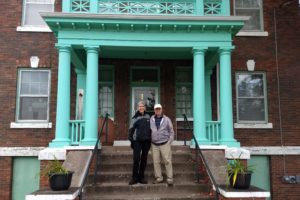The Mormon Station state park has such a wonderful display of history of Genoa, Carson Valley, and Nevada’s statehood. First we’ll build on what we covered in part 26 and then add some colorful details.

In 1845, Texas was annexed by the U.S. from Mexico and the two countries went to war. The U.S. ended up adding Texas as a state in 1848 and gaining the territory that now makes up the state of Nevada after paying a lot of money to Mexico for this land. (Remember all we looked at while along the Rio Grande?)

In 1848 with gold discovered at Sutter’s Mill, the U.S. laid claim to the land known as California and granted statehood in 1850. Promise of gold and statehood brought in people from the east as well as from around the world.

In 1850, this territory the U.S. bought from Mexico was divided into the state of California and the territories of New Mexico and Utah.

While closer to California, Carson Valley became a part of the Utah Territory in 1850. More than 500 miles away from the territorial capital at Salt Lake City and with deserts and mountains in-between, the isolated settlers at Mormon Station and other residents wanted some civil courts and law enforcement, so they met in 1851 to form a “squatter government.”

The first land claim was in 1852. Claim was for land extending from “the lone tree . . . running north to the Old Mormon Station thence east to the River thence south along the River to a point due east from the lone tree.”

The Utah Legislature finally formed Carson County in 1854 but a government wasn’t set up until Orson Hyde was appointed to be a probate judge and presiding church authority in the region. He arrived in June 1855 with 100 families to help settle Carson Valley and nearby valleys.

Hyde renamed the community Genoa in 1855 and designated it as the county seat. More Mormons arrived and settled in the area. Relations between Mormons and “Gentiles” grew increasingly hostile so that non-Mormons wanted annexation of Carson Valley and nearby valleys.

As Mormons moved out, others moved in, including prospectors. Changes would be happening soon to make Nevada a state and remove the Mormon Station as the center of history

Silver drew prospectors back east across the Sierras because of the Comstock Lode. Mining towns further north in the valley became boom towns.

Shift in population from Genoa northward to Carson City and Virginia City put pressure on the Utah Legislature to provide responsive local government. A provisional territorial government was established for Nevada in 1861 with Carson City as the new territorial capital.

Territorial status and freedom from Utah in 1861 because of the population explosion from the discovery of the Comstock Lode. Officials were put in place to keep Nevada loyal to the union. Orion Clemens was one official, which meant that his younger brother, Samuel Clemens (Mark Twain), came to visit and learned about territorial politicians that he would poke fun at later on.

In 1864, Nevada officially became a state, more for political than economic reasons.

more-than-history info
This description of the journey through Nevada as emigrants came to Mormon Station is amazing.

Most travelers going west used light farm wagons called prairie schooners because their canvas tops reminded them of sails on a ship. Schooners could carry about a ton of food and supplies.

Have you heard these sayings before?


women and our pretty things


a calendar-clock-food safe all in one


A stitching horse for stitching saddles and harnesses; lever on the side allows the worker to adjust the tension. The clamp holds the leather so both of the worker’s hands were free.


The first Ferris wheel? More about this in the next post.


Abner Blackburn was the one who figured out exactly where the Mormon Station as a trading post should be located based on his travels for years in the area.

Recreation of Mormon Station that’s now the museum.





